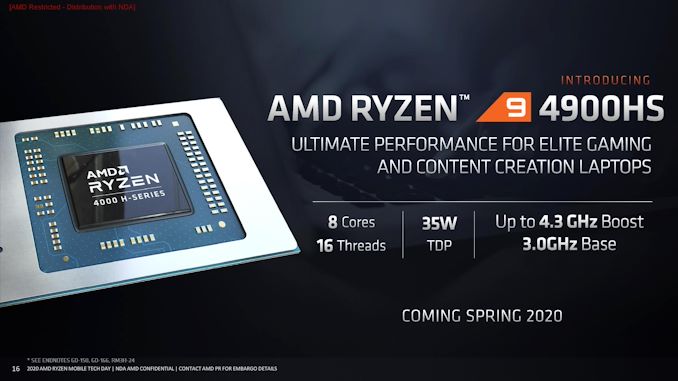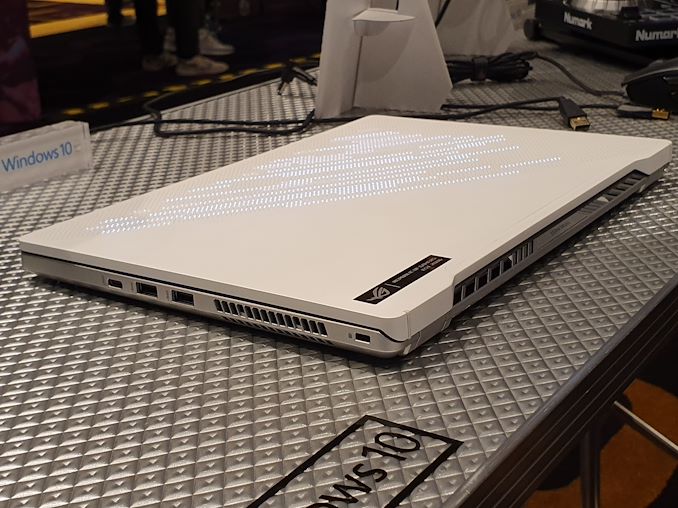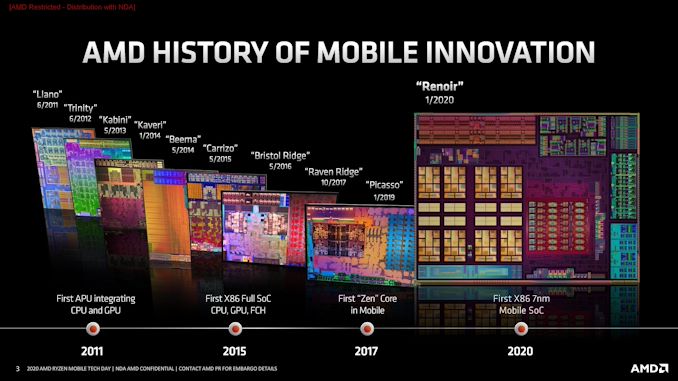AMD Announces Ryzen 9 4900H and 4900HS: The Halo 35 W and 45 W Mobile APUs
by Dr. Ian Cutress on March 16, 2020 9:00 AM EST- Posted in
- CPUs
- AMD
- APUs
- 35W
- 45W
- Ryzen Mobile
- Ryzen 9
- Ryzen 4000
- Ryzen 9 4900HS

As part of the disclosures on AMD’s Ryzen Mobile 4000 portfolio, the company is also lifting the lid on perhaps one of the worst kept secrets in mobile computing: the new top-of-the-line Ryzen 9 4900H family. This family consists of two processors, the standard H model built for 45 W operation, and the HS model at 35 W. These parts will offer more frequency and more graphics performance than the rest of AMD’s offerings, and are the only APUs from AMD to carry the weight of the Ryzen 9 branding.
We saw from AMD’s first announcement of its Ryzen Mobile 4000 family back in January that it was eager to attack the notebook market with its Zen 2-based 7nm products, featuring up to 8 cores and an updated Vega graphics engine. With the Zen 2 cores being a resounding success on the desktop in chiplet form, the monolithic APU market is where AMD has to ride over previous barriers to performance and marketability, and the belief in the company is that it will do so through 2020 with a combination of high performance x86 products delivering ‘superior’ graphics performance all while achieving multiple design wins. In January we saw several of those design wins in the flesh, such as the ASUS Zephyrus G14, the only 14-inch laptop with both a H-class processor and a discrete GPU, as well as an array of thin and light designs all based on the U-series family.

ASUS Zephyrus G14, with Ryzen 7 4800HS
The Ryzen 9 offerings from AMD are meant to be designated the best of the best, and one of the announcements missing in January was a mobile-class Ryzen 9 processor. Despite the lack of AMD mentioning one, it was a number of AMD’s OEM partners that spoke out of turn, showcasing various notebook designs with labels such as ‘Up to AMD Ryzen 9’ on the packaging, indicating that we were set to see a Ryzen 9 product in the portfolio. The official announcement is today, with the Ryzen 9 4900H and the Ryzen 9 4900HS.
| AMD Ryzen Mobile 4000 APUs | |||||||
| AnandTech | Cores Threads |
Base Freq |
Turbo Freq |
L2 | L3 | GPU CUs GPU Freq |
TDP |
| H-Series | |||||||
| Ryzen 9 4900H | 8 / 16 | 3.3 GHz | 4.4 GHz | 4 MB | 8 MB | 8 / 1750 MHz | 45 W |
| Ryzen 9 4900HS | 8 / 16 | 3.0 GHz | 4.3 GHz | 4 MB | 8 MB | 8 / 1750 MHz | 35 W |
| Ryzen 7 4800H | 8 / 16 | 2.9 GHz | 4.2 GHz | 4 MB | 8 MB | 7 / 1600 MHz | 45 W |
| Ryzen 7 4800HS | 8 / 16 | 2.9 GHz | 4.2 GHz | 4 MB | 8 MB | 7 / 1600 MHz | 35 W |
| Ryzen 5 4600H | 6 / 12 | 3.0 GHz | 4.0 GHz | 3 MB | 8 MB | 6 / 1500 MHz | 45 W |
| Ryzen 5 4600HS | 6 / 12 | 3.0 GHz | 4.0 GHz | 3 MB | 8 MB | 6 / 1500 MHz | 35 W |
| U-Series | |||||||
| Ryzen 7 4800U | 8 / 16 | 1.8 GHz | 4.2 GHz | 4 MB | 8 MB | 8 / 1750 MHz | 15 W |
| Ryzen 7 4700U | 8 / 8 | 2.0 GHz | 4.1 GHz | 4 MB | 8 MB | 7 / 1600 MHz | 15 W |
| Ryzen 5 4600U | 6 / 12 | 2.1 GHz | 4.0 GHz | 3 MB | 8 MB | 6 / 1500 MHz | 15 W |
| Ryzen 5 4500U | 6 / 6 | 2.3 GHz | 4.0 GHz | 3 MB | 8 MB | 6 / 1500 MHz | 15 W |
| Ryzen 3 4300U | 4 / 4 | 2.7 GHz | 3.7 GHz | 2 MB | 4 MB | 5 / 1400 MHz | 15 W |
AMD’s H processors have a TDP of 45 W, indicating that at sustained load (with enough temperature headroom), the CPU will run at 45 W, and try and take the best frequency it can at 45 W.
The HS processors are a bit different to the H processors. They mostly have the same frequencies (except the Ryzen 9), but are labelled as 35 W in the default configuration. That means it will still try and aim for the best frequency, but the sustained power consumption is only 35 W. Not everyone can buy the HS processor – AMD reserves these parts for OEM partners that it works in tandem with to give the best experience. The first HS system into the market will be that ASUS Zephyrus G14, and that system will have a short exclusivity on the Ryzen 7 version parts.
Note that the normal H processors can also be set at 35 W by the OEM, but that won’t make them a HS processor – the S means that AMD has validated the design, and AMD has the units in house and pre-tests any updates to the notebooks before the updates get released. This comes from AMD’s two Continuous Validation Labs, one in Austin and one in Shanghai. We (the press) postulated that the ‘HS’ stands for ‘High School’, with these parts being targeted for the back-to-school designs. AMD corrected us, saying that the H is just the class, and the S stands for Special.
With regards the Ryzen 9 processors, AMD initially actually only gave us the specifications of the 4900HS, with the 4900H ‘to be disclosed'. This could have been for two reasons – firstly that the 4900HS might be the only model we’ll see, that AMD wants to keep it for those designs formed from collaboration with OEMs, or secondly that it’s a high enough binning of a chip that they want to dedicate the first batches to those collaborations. In the end, the day before this announcement, we discovered the details in the latest version of the slide decks. Nonetheless, the Ryzen 9 4900HS sits +100 MHz above the Ryzen 7 parts, with one extra compute unit and +150 MHz on the graphics frequency, and the Ryzen 9 4900H is +300 MHz on the base over the 4900HS, and +100 MHz on the turbo. All the parts are PCIe 3.0, for power reasons.
The Ryzen 9 4900H and Ryzen 9 4900HS are expected to hit the market in the Spring (Q2?) of 2020. Given the recent global situation, it might be out in China before it comes to the rest of the world.











37 Comments
View All Comments
PeachNCream - Monday, March 16, 2020 - link
Interesting that 35W TDP is in the range of halo products. That was standard TDP for mobile CPUs in mundane Latitudes and ProBooks back when Sandy Bridge and Ivy Bridge were being sold.R3MF - Monday, March 16, 2020 - link
Would love to see a Razer Blade-Stealth using the 4900HS.wr3zzz - Monday, March 16, 2020 - link
There are probably two types of halo products nowadays: 5-15W sleek sleeves under 2.5lb and gaudy 5lb+ 45W+ gaming bricks with dGPU named similar to desktop parts. 45W APU or even 35W APU really belong to the workhorse group.PeachNCream - Monday, March 16, 2020 - link
That's sort of what I was thinking. Certainly 35W parts appear to fall into that workhorse realm. Maybe one could argue that 45W parts are halo processors without making too much of a stretch. Then again, I have a *very* old AMD Athlon II P360 in my laptop that is rated at 25W TDP and how we categorize products tends to change over time.0ldman79 - Monday, March 16, 2020 - link
Then we have systems like my Dell Inspiron 7559, 45W CPU + 50W 960M, under 6 lbs.Excellent cooling, no throttling, play with the power settings and you can see 10 hours battery life. Typical watching a 1080P movie is almost 4 hours.
I don't see the point of 15W laptops even near the 5 lbs mark. That should be 3 lbs *or* 15W with a giant battery and 20 hours battery life.
EliteRetard - Monday, March 16, 2020 - link
I'm partially copying my post from the other article.I've been begging for a logical laptop for the masses. I seriously can't understand why OEMs have refused to even consider it. In what other industry do manufactures refuse to service the needs of 80% to cater only for the odd 20%?
The vast majority of people don't need a DGPU, but they are currently forced to buy one if they want any performance CPU. That costs them more money, increases weight, and reduces battery life (two fold, less space for battery and higher draw).
80% of the market would be incredibly well served with a 35w HS APU.
For the 10% who want battery life over anything, they can get a 15w U series.
For the 10% who want gaming/workstation they can get a 45w H series + GPU.
Imagine if you could only buy a 2 seat scooter for $15+k, or a massive 4 door 8ft bed truck for $100+k. And there are literally no other options, new or used...there has been only these two choices being sold by every car maker in the entire world. If you want to do anything more than a scooter can handle, you are literally forced to buy a massive overkill option no matter how impractical. That's literally how the laptop market has been for almost a decade.
I desperately hope they will make a laptop with the 35-45w APU and NO DGPU.
And not some piece of crap with single channel, terrible screen, 128GB SSDs or HDDs etc.
Based on current Intel designs and prices, I think it should be possible to retail a decent H/HS IGP only option in the $600 range, with premium options starting at $750 (quality slim bezel 15" 1080, high speed 16GB, 512GB SSD, 60+WHr, great wifi, etc).
lmcd - Monday, March 16, 2020 - link
Was just about to post the same thing. I want a laptop that can idle fine (spoiler alert: most of them can) but I don't mind an extra 1/4 inch to 1/2 inch for the proper cooling to get me a 45w processor. If I attach my laptop in a reasonable-temperature room to a desktop dock, I should be able to forget that it's a laptop (with a good enough dock, of course).Irata - Monday, March 16, 2020 - link
I think the most important part is the fact that not everyone can get these halo APU.Guess AMD became tired of their processors being used in craptops / poorly designed systems and are now able to do something about it.
Imho, they should extend the requirement that you can only get the halo CPU if your lower tier models also follow at least minimum design guidelines.
timecop1818 - Monday, March 16, 2020 - link
So there's no GPU included here at all? OEMs would need to bundle mobile radeon, or some nvidia offering, while increasing TDP? Meanwhile intel has ice lake/comet lake WITH a decent iGPU, all while fitting into the 35/45W envelope. So what's the big deal with this announcement?csutcliff - Monday, March 16, 2020 - link
All of the 4000 series APUs (U & H/HS) contain a 7nm Vega-based GPU with up to 8 CUs. It is expected that most models with H/HS APUs will also contain a discrete GPU.